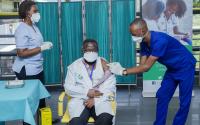[ad_1]
A systematic review and meta-analysis of 10 randomized controlled studies concludes that use of convalescent plasma in COVID-19 patients doesn’t appear to improve survival or clinical status, shorten hospital stays, or reduce the need for mechanical ventilation.
Led by researchers at the University of Basel in Switzerland and published late last week in JAMA, the study found that the risk ratio (RR) for death in the four peer-reviewed, published trials involving 1,060 coronavirus patients was 0.93 (95% confidence interval [CI], 0.63 to 1.38; absolute risk difference, -1.21% (95% CI, -5.29% to 2.88%). The death rate in patients who received convalescent plasma was 11.6%, compared with 12.7% in controls.
After adding 6 unpublished studies (5 preprints, 1 news release) including 10,722 patients, the RR was 1.02 (95% CI, 0.92 to 1.12).
“Treatment with convalescent plasma compared with placebo or standard of care was not significantly associated with a decrease in all-cause mortality or with any benefit for other clinical outcomes,” the researchers said.
Of the four peer-reviewed trials, the summary hazard ratio (HR) for length of hospital stay was 1.17 (95% CI, 0.07 to 20.34). The summary RR for mechanical ventilation was 0.76 (95% CI, 0.20 to 2.87; absolute risk difference, -2.56% [95% CI, -13.16% to 8.05%]). Neither clinical improvement or deterioration nor severe adverse events were significantly different between those receiving convalescent plasma and controls, although data were limited owing to insufficient reporting and inconsistent definitions.
Convalescent plasma is collected from volunteer donors who have recovered from COVID-19 on the basis that their antibodies could protect against severe infection in ill coronavirus patients.
Table of Contents
Low to moderate uncertainty
Of the 10 randomized controlled trials in the analysis, three were conducted in India, two in Argentina, and one each in Bahrain, China, the Netherlands, Spain, and the United Kingdom. Five trials were stopped early, two of them due to futility and three due to slow enrollment. Two trials were double-blinded, while the remaining eight were open-label.
One trial included outpatients, five involved hospitalized patients needing supplemental oxygen, and four included hospitalized patients, regardless of supplemental oxygen requirement. Plasma with high concentrations of coronavirus antibodies was used in four trials, while one used low concentrations, three didn’t have a minimum concentration, and two were unclear about the levels used. Mean patient age in the nine trials with detailed patient characteristics was younger than 70 years, and 80% or more were men.
The authors pointed out that the certainty of the evidence was low to moderate for death from any cause and low for the other outcomes. To enable better synthesis and analysis of findings and more definitive outcomes, they called for creation of uniform outcome measurement across COVID-19 trials. “To aid the development of uniform outcome measurement across trials, core outcome sets involving patients may be a fruitful way forward,” they wrote.
Although the US Food and Drug Administration granted emergency use authorization for convalescent plasma for the treatment of COVID-19 based on observational data in August 2020, clinical evidence for or against its use is lacking, with only a few trials published in peer-reviewed journals and the rest only preliminary results posted on preprint servers, the authors said.
In addition, preliminary results of the largest coronavirus treatment platform trial, Randomized Evaluation of COVID-19 Therapy (RECOVERY), showed no clinical benefit of convalescent plasma in lowering the risk of death over usual care (RR, 1.04; 95% CI, 0.95 to 1.14) in 10,406 patients. The convalescent plasma arm of that trial was stopped in January 2021 at the recommendation of the data monitoring committee.
Less competition, more coordination
In an editorial in the same journal, Derek Angus, MD, of the University of Pittsburgh (also a JAMA senior editor); Anthony Gordon, MD, of Imperial College London; and Howard Bauchner, MD, JAMA editor-in-chief, noted that although more than 100,000 US COVID-19 patients have received convalescent plasma, the 10-trial meta-analysis included no US studies.
Moreover, only a few thousand of the nearly 30 million COVID-19 patients in the United States have participated in randomized controlled trials. “Given the number of patients with COVID-19 in the US, the available resources, the number of major academic research centers, and the pressing need to have rapid, actionable evidence on optimal treatment, the US surely should have done better,” Angus and colleagues wrote.
The reasons behind the lack of mobilization and participation are twofold, they said, including the fragmented structure of the US clinical research enterprise and the ineffective interface between clinical research and patient care. “A system that rewards investigators for championing their ideas to the exclusion of others, with no national prioritization, regardless of its merits during normal times, is neither efficient during a pandemic nor aligned with the principle of public goods (knowledge about what works to treat COVID-19 is arguably the ultimate public good),” the authors wrote.
In addition, no single organization oversees coordination between research and clinical care in the United States, requiring individual investigators to persuade clinicians to refer their patients to their trials, with the clinicians often preferring to avoid the complications and complexities of participation.
The United Kingdom, on the other hand, has successfully conducted COVID-19 treatment trials because clinicians and healthcare administrators all work for a single payer and care delivery system, and the country had already established a national clinical research coordination, prioritization, oversight, and funding system before the pandemic.
Angus and colleagues recommend implementing a national hospital payment system for clinical trial participation, giving priority to trials simple enough to be conducted anywhere, and facilitating data sharing and interoperability between research and clinical care.
“As with the chaotic national rollout of immunizations, which shares some of the same problems, the US needs to create a more effective environment to conduct clinical research at the national level that is embedded both culturally and electronically within clinical care,” they concluded.
[ad_2]
Source link












